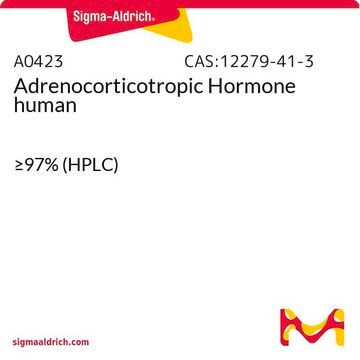A7699
Adenosine 5′-triphosphate disodium salt hydrate
BioXtra, ≥99% (HPLC), from microbial
Synonym(s):
ATP disodium salt
About This Item
Recommended Products
biological source
microbial
product line
BioXtra
Assay
≥99% (HPLC)
form
powder
impurities
≤0.1% inorganic P
≤3% solvent content
pKa
(1) 4.0, (2) 6.5
solubility
H2O: 50 mg/mL, clear, colorless
anion traces
chloride (Cl-): ≤0.05%
cation traces
Al: ≤0.005%
Ca: ≤0.01%
Cu: ≤0.001%
Fe: ≤0.05%
K: ≤0.01%
Mg: ≤0.005%
NH4+: ≤0.05%
Pb: ≤0.001%
Zn: ≤0.0005%
λmax
259 nm
storage temp.
−20°C
SMILES string
O.[Na+].[Na+].Nc1ncnc2n(cnc12)[C@@H]3O[C@H](COP(O)(=O)OP([O-])(=O)OP(O)([O-])=O)[C@@H](O)[C@H]3O
InChI
1S/C10H16N5O13P3.2Na.H2O/c11-8-5-9(13-2-12-8)15(3-14-5)10-7(17)6(16)4(26-10)1-25-30(21,22)28-31(23,24)27-29(18,19)20;;;/h2-4,6-7,10,16-17H,1H2,(H,21,22)(H,23,24)(H2,11,12,13)(H2,18,19,20);;;1H2/q;2*+1;/p-2/t4-,6-,7-,10-;;;/m1.../s1
InChI key
NTBQNWBHIXNPRU-MSQVLRTGSA-L
Looking for similar products? Visit Product Comparison Guide
Application
Biochem/physiol Actions
Storage Class Code
11 - Combustible Solids
WGK
WGK 2
Flash Point(F)
Not applicable
Flash Point(C)
Not applicable
Personal Protective Equipment
Certificates of Analysis (COA)
Search for Certificates of Analysis (COA) by entering the products Lot/Batch Number. Lot and Batch Numbers can be found on a product’s label following the words ‘Lot’ or ‘Batch’.
Already Own This Product?
Find documentation for the products that you have recently purchased in the Document Library.
Customers Also Viewed
Protocols
ZIC®-cHILIC is a densely bonded zwitterionic stationary phase with phosphorylcholine functional groups covalently attached to silica.
HILIC separation is an alternative that permits sensitive MS detection and without the use of ion-pair reagents.
Our team of scientists has experience in all areas of research including Life Science, Material Science, Chemical Synthesis, Chromatography, Analytical and many others.
Contact Technical Service










